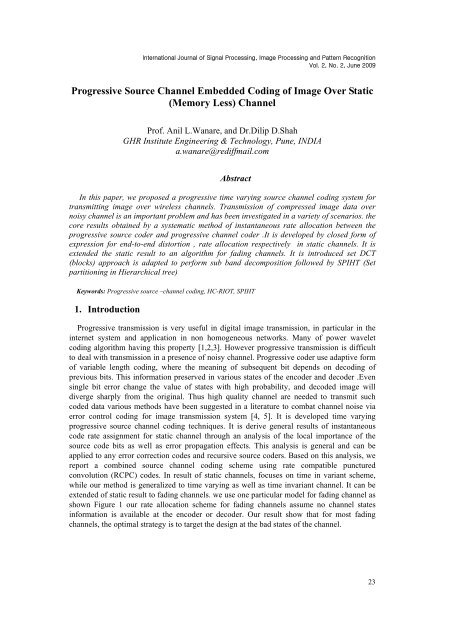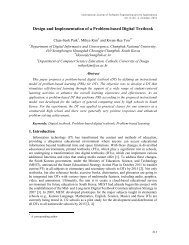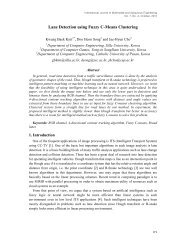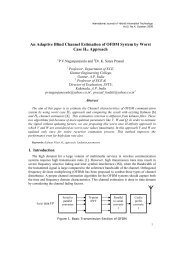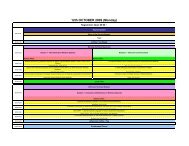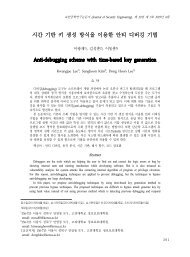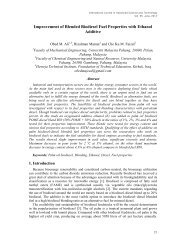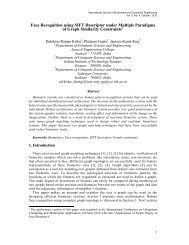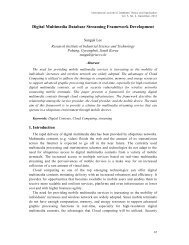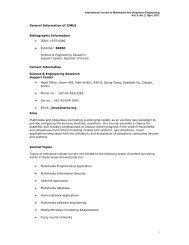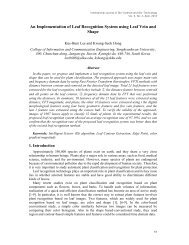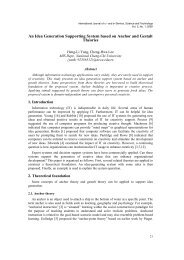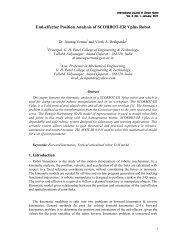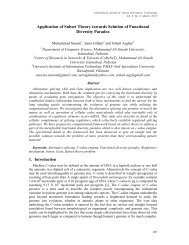Progressive Source Channel Embedded Coding of Image ... - SERSC
Progressive Source Channel Embedded Coding of Image ... - SERSC
Progressive Source Channel Embedded Coding of Image ... - SERSC
You also want an ePaper? Increase the reach of your titles
YUMPU automatically turns print PDFs into web optimized ePapers that Google loves.
International Journal <strong>of</strong> Signal Processing, <strong>Image</strong> Processing and Pattern Recognition<br />
Vol. 2, No. 2, June 2009<br />
<strong>Progressive</strong> <strong>Source</strong> <strong>Channel</strong> <strong>Embedded</strong> <strong>Coding</strong> <strong>of</strong> <strong>Image</strong> Over Static<br />
(Memory Less) <strong>Channel</strong><br />
Pr<strong>of</strong>. Anil L.Wanare, and Dr.Dilip D.Shah<br />
GHR Institute Engineering & Technology, Pune, INDIA<br />
a.wanare@rediffmail.com<br />
Abstract<br />
In this paper, we proposed a progressive time varying source channel coding system for<br />
transmitting image over wireless channels. Transmission <strong>of</strong> compressed image data over<br />
noisy channel is an important problem and has been investigated in a variety <strong>of</strong> scenarios. the<br />
core results obtained by a systematic method <strong>of</strong> instantaneous rate allocation between the<br />
progressive source coder and progressive channel coder .It is developed by closed form <strong>of</strong><br />
expression for end-to-end distortion , rate allocation respectively in static channels. It is<br />
extended the static result to an algorithm for fading channels. It is introduced set DCT<br />
(blocks) approach is adapted to perform sub band decomposition followed by SPIHT (Set<br />
partitioning in Hierarchical tree)<br />
Keywords: <strong>Progressive</strong> source –channel coding, HC-RIOT, SPIHT<br />
1. Introduction<br />
<strong>Progressive</strong> transmission is very useful in digital image transmission, in particular in the<br />
internet system and application in non homogeneous networks. Many <strong>of</strong> power wavelet<br />
coding algorithm having this property [1,2,3]. However progressive transmission is difficult<br />
to deal with transmission in a presence <strong>of</strong> noisy channel. <strong>Progressive</strong> coder use adaptive form<br />
<strong>of</strong> variable length coding, where the meaning <strong>of</strong> subsequent bit depends on decoding <strong>of</strong><br />
previous bits. This information preserved in various states <strong>of</strong> the encoder and decoder .Even<br />
single bit error change the value <strong>of</strong> states with high probability, and decoded image will<br />
diverge sharply from the original. Thus high quality channel are needed to transmit such<br />
coded data various methods have been suggested in a literature to combat channel noise via<br />
error control coding for image transmission system [4, 5]. It is developed time varying<br />
progressive source channel coding techniques. It is derive general results <strong>of</strong> instantaneous<br />
code rate assignment for static channel through an analysis <strong>of</strong> the local importance <strong>of</strong> the<br />
source code bits as well as error propagation effects. This analysis is general and can be<br />
applied to any error correction codes and recursive source coders. Based on this analysis, we<br />
report a combined source channel coding scheme using rate compatible punctured<br />
convolution (RCPC) codes. In result <strong>of</strong> static channels, focuses on time in variant scheme,<br />
while our method is generalized to time varying as well as time invariant channel. It can be<br />
extended <strong>of</strong> static result to fading channels. we use one particular model for fading channel as<br />
shown Figure 1 our rate allocation scheme for fading channels assume no channel states<br />
information is available at the encoder or decoder. Our result show that for most fading<br />
channels, the optimal strategy is to target the design at the bad states <strong>of</strong> the channel.<br />
23
International Journal <strong>of</strong> Signal Processing, <strong>Image</strong> Processing and Pattern Recognition<br />
Vol. 2, No. 2, June 2009<br />
2. Problem Formulation<br />
We use the output <strong>of</strong> a progressive source coder as the input data stream into proposed<br />
algorithm. Input stream is divided into some blocks. Each block is supplemented with a cycle<br />
redundancy check (CRC) error control coding .the error detection code assure that the<br />
decoder will know if an unrecoverable error occurs, and will in the event stop decoding<br />
Assume static binary symmetric channel (BSC). Cross over probability or bit –error rate<br />
(BER) <strong>of</strong> the BSC is denoted by , and P n<br />
is the probability that block n after decoding,<br />
that is P<br />
n<br />
is the probability that block n is not recovered correctly at the decoder. The partials<br />
distortion due to successful decoding <strong>of</strong> all blocks prior to n be denoted by d<br />
n<br />
. The total end<br />
to end distortion <strong>of</strong> the system is denoted by D . l n<br />
is the length <strong>of</strong> packet n subsequent to<br />
channel coding.<br />
Total length can be written in term <strong>of</strong> probabilities <strong>of</strong> error free decoding up block n ,<br />
which means there is no error in the blocks one through n .and there is an error in block n 1.<br />
This probability is equal to<br />
According to system that the first and last block need special treatment, the total distortion<br />
for static channel is<br />
(1)<br />
(2)<br />
,<br />
where N is total number <strong>of</strong> channel blocks. to minimize the distortion according to the<br />
total channel transmission rate[6].<br />
Where,<br />
dn<br />
are given through the rate distortion curves <strong>of</strong> the source code.<br />
N<br />
ln<br />
L<br />
(4)<br />
n1<br />
L is the total number <strong>of</strong> bits available, to be divided in to source coder and channel coder. The<br />
optimization problem is over N and l m<br />
. N Determines the trade<strong>of</strong>f between the source<br />
coding bits and l m<br />
determines the how the total available channel protection is given to over<br />
different blocks. After solving equation (4), it can be written as l m<br />
in terms <strong>of</strong> P<br />
n<br />
, the<br />
probability <strong>of</strong> block error. It can be approximately a log affine function, according block error<br />
rate under different channel code rate while channel BER is e 0.1 a shown in figure 1.<br />
(3)<br />
(5)<br />
The channel BER e is inside the model parameters P and Q , and will not appear further<br />
.using equation (5) according to Gilbert-Elliot model. The optimization constraint can be<br />
written as follows.<br />
24
International Journal <strong>of</strong> Signal Processing, <strong>Image</strong> Processing and Pattern Recognition<br />
Vol. 2, No. 2, June 2009<br />
(6)<br />
For non variable N , considering equilibrium <strong>of</strong> the Lagrangian solution lies as<br />
(7)<br />
Block Error Rate with RCPC (e=0.12, Multi <strong>Channel</strong>s)<br />
Block Error Rate<br />
1/channel Code Rate<br />
Figure 1. Block error rate under different channel code rate at the rate <strong>of</strong> BER is<br />
e=0.12<br />
Taking derivative <strong>of</strong> the above equation (7) with respect Pj<br />
and setting it to zero yield a<br />
system <strong>of</strong> equations. Inverting and subtracting two subsequent element <strong>of</strong> this system <strong>of</strong><br />
equations gives.<br />
(8)<br />
Which is recursive solution for P<br />
j<br />
? Solving for equilibrium state j N gives<br />
0 .substituting in equation (8) it gives P j1<br />
Pj<br />
The optimal each block error are non decreasing, this analysis is completely general for static<br />
channel , and it can be applied with any progressive source code and anywhere in the channel<br />
coding for finding optimal time varying and invariant rate allocation between a progressive<br />
source coder and channel coder.<br />
In the proposed scheme, it is necessary in the transmission <strong>of</strong> data, channel protection is<br />
time varying. To limit the rate impact <strong>of</strong> over head into account three facts first is, and there<br />
are only a finite number <strong>of</strong> channel codes in the system. Second, channel code is constant<br />
over each block and in the third; channel error protection is uniformly non-increasing [5].<br />
3. Time varying static channels<br />
The time varying static channel modeled as finite state Markov process [7]. According to G<br />
25
International Journal <strong>of</strong> Signal Processing, <strong>Image</strong> Processing and Pattern Recognition<br />
Vol. 2, No. 2, June 2009<br />
& E model, the channel is described by binary symmetric channel (BSC) with a particular Bit<br />
error rate (BER).Bit error rate is denoted by E b<br />
for noisy state (bad state) and E g<br />
for less<br />
noisy state (good state).Because <strong>of</strong> instantaneous state <strong>of</strong> the channel and variation in BER it<br />
is proposed for single BER and it is denoted by E d<br />
which designed for that. E d<br />
can be set<br />
high with few bits available for source coding. And set different values <strong>of</strong> E<br />
d<br />
to obtain the<br />
result as shown figure 2.<br />
Figure 2. Effect <strong>of</strong> rate allocation in on end-to-end PSNR Experiment on baboon<br />
512x512 size.<br />
The behavior from above curve a conservative approach to protect error in static (memory<br />
less channel).in a 512x512 baboon image, compressed with SPIHT and DCT, combination <strong>of</strong><br />
these is nothing but(Homogeneous Connected Region Interested Ordered Transmission<br />
Technique ) HC-RIOT coder [7] is sent through BSC and it compatibility with RCPC used to<br />
protect error in static channel. According to modulation, coding and multi user decoding [8]<br />
for source block length is 225, to which is added 8bits <strong>of</strong> hamming code [9].If baboon is<br />
transmitted through static BSC with BER 0.12. The block error rates <strong>of</strong> the system under<br />
different code rate are obtained in this particular proposed system. Code rate can be decided<br />
by the equation (4).for optimization to protect the error at BER 0.1 and transmit 0.25 bpp.The<br />
impact <strong>of</strong> overhead on transmitting rate is 0.01bpp. According to our experiment for various<br />
channels sharing BER 0.12.table 1a shows the means and variance <strong>of</strong> PSNR in each channel.<br />
All static channels having more PSNR as compare to fading channels. If E<br />
b<br />
putting highest<br />
value, decoding collapse due non compatibility. In comparison, the first bad state channel and<br />
second channel almost the same but good state <strong>of</strong> the channel first is 12 times better than<br />
channel second. The effect <strong>of</strong> bad state channel is dominant in all selected channels due to the<br />
some decreasing the value <strong>of</strong> PSNR as E b<br />
increases from E d<br />
.According to the experiment<br />
BER chosen to be at ,or very close to E<br />
b<br />
. The transmitting process in choice <strong>of</strong> E<br />
d<br />
is to have<br />
less digital image and more protection or more digital image data and less protection.<br />
Figure 3. <strong>Source</strong> <strong>Image</strong> Homogenous Connected Region<br />
26
International Journal <strong>of</strong> Signal Processing, <strong>Image</strong> Processing and Pattern Recognition<br />
Vol. 2, No. 2, June 2009<br />
Above figure is indicating the progressive transmission scheme according to HC-RIOT<br />
technique. if BER is varied the PSNR for the channel 4,5, shows , it observed that the best<br />
design BER again coincides with the BER <strong>of</strong> the bad state <strong>of</strong> the static channel as shown in<br />
figure 4.<br />
<strong>Channel</strong> cros over & parameters for Good<br />
and bad st ates<br />
0.15<br />
0.1<br />
0.05<br />
0<br />
Eg<br />
Eb<br />
channel<br />
01<br />
channel<br />
02<br />
channel<br />
03<br />
channel<br />
04<br />
channel<br />
05<br />
channel no<br />
Figure 4. <strong>Channel</strong> cross over and parameters<br />
Table 1. shows the means <strong>of</strong> PSNR in each channel<br />
Average PSNR<br />
Rate 0.12 0.50 1.00<br />
BSC 26.65 32.45 35.38<br />
<strong>Channel</strong>- 01 26.57 32.30 34.98<br />
<strong>Channel</strong>- 02 26.54 32.22 34.72<br />
<strong>Channel</strong>- 03 26.42 32.12 34.67<br />
<strong>Channel</strong>- 04 26.34 32.08 34.23<br />
channel -05 26.13 32.01 34.12<br />
Table 1a. shows the variance <strong>of</strong> PSNR in each channel<br />
Variance <strong>of</strong> PSNR<br />
Rate 0.12 0.50 1.00<br />
BSC 0.33 0.72 0.80<br />
channel -01 0.59 0.90 1.23<br />
channel -02 0.79 1.13 1.45<br />
channel- 03 0.90 1.32 1.89<br />
channel -04 1.12 1.48 1.98<br />
channel -05 1.23 1..88 2.35<br />
Table 2. Average PSNR for baboon 512X512 size over BSC with BER 0.12for<br />
fixed and variable<br />
Rate 0.1 0.2 0.4 0.6 0.8<br />
Fixed 26.33 28.64 31 33 35.3<br />
Variable 26.83 28.97 32 33.5 35.2<br />
27
International Journal <strong>of</strong> Signal Processing, <strong>Image</strong> Processing and Pattern Recognition<br />
Vol. 2, No. 2, June 2009<br />
Ave rage PSNR for BSC & other<br />
channels(Different BER)<br />
40<br />
30<br />
20<br />
10<br />
0<br />
0.12<br />
0.5<br />
1<br />
BSC & Static channels<br />
4. Hc-riot technique<br />
Figure 5. Average PSNR for different BER 0.12, 0.5&1.0<br />
HC-RIOT (Homogeneous connect region interested ordered transmission technique) [6] is<br />
nothing but the joined uniform part <strong>of</strong> the image having definable boundary, which is<br />
concerned for progressive transmission. It is introduced set DCT (blocks) approach is adapted<br />
to perform sub band decomposition followed by SPIHT (Set partitioning in Hierarchical tree)<br />
Homogenous connected region interested ordered transmission technique, in this technique<br />
insignificant (Discrete cosine transform) DCT coefficient that correspond to the some spatial<br />
location in sub band [11]. Sub band can be use to reduce the redundancy by set partitioning in<br />
hierarchical tree(SPIHT) in addition .It is introduced the idea <strong>of</strong> how set partitioning can be<br />
used in sorting transform coefficients that image distortion is minimize during image<br />
transmission. DCT-SPIHT image compression reduce the computational complexity and<br />
improve the quality <strong>of</strong> the reconstructed image according to the threshold level can be<br />
transmit the coefficients, threshold level can be decided by using largest magnitude<br />
coefficients in transmission method Homogenous connected region interested ordered<br />
transmission technique can be implemented with the following steps to be used by the<br />
encoder.<br />
Step 1: calculate the ‘n’ to select the threshold level:<br />
n log<br />
2 max i, j C i,<br />
j<br />
<br />
(9)<br />
Step 2: for sorting purpose; followed by the pixel coordinates m (k) and sign each <strong>of</strong> the<br />
n 1<br />
n<br />
coefficients such that 2 │C k │ 2 <br />
(Sorting Pass)<br />
m<br />
<br />
Step 3: output the n th n 1<br />
most significant bit <strong>of</strong> all the coefficients with │C i,<br />
│j<br />
2 <br />
if required,<br />
those that had their coordinate transmitted in previous sorting passes<br />
Step 4: Decrement n by one and to go to step 2.<br />
The above steps that can be implemented and stop at the desired the rate or distortion<br />
normally, good quality images can be recovered after a relatively small amount <strong>of</strong> the<br />
coefficients are transmitted. In a practical implementation purpose the significance<br />
information is stored in three-ordered list as.<br />
LIS: List <strong>of</strong> insignificant set contains sets <strong>of</strong> discrete cosine transform coefficients which are<br />
defined by tree structures [5] and which had been found have magnitude smaller than the<br />
threshold (insignificant)<br />
28
International Journal <strong>of</strong> Signal Processing, <strong>Image</strong> Processing and Pattern Recognition<br />
Vol. 2, No. 2, June 2009<br />
5. Conclusion<br />
This paper presents a new low complexity technique for <strong>Progressive</strong> <strong>Source</strong> <strong>Channel</strong><br />
<strong>Embedded</strong> <strong>Coding</strong> <strong>of</strong> digital <strong>Image</strong> over Static (Memory Less) <strong>Channel</strong> based on HC-RIOT.<br />
The proposed system to find the optimal time varying rate for progressive joint source<br />
channel coding. This system can be applied to any progressive transmission and anywhere to<br />
transmit the digital image. For static channel the effect <strong>of</strong> channel error propagation to the<br />
decoder and instantaneous trade<strong>of</strong>f between source and error protection bits. In this particular<br />
static channel, it generalized to a system for memory less channels. Simulation gives time<br />
varying allocation provides maximum up to 0.41dB.Desired gain obtained at high bit error<br />
rate and less transmission rate.<br />
It is found that in static channel, optimal design bit error rate is always very close to the<br />
BER <strong>of</strong> the noisy state. Hence, this new system makes a fast and low complexity coding for<br />
static as well as fading channels.<br />
Acknowledgement<br />
The authors wish to thank the anonymous reviewers. The author would like to thank for<br />
useful comments and also thanks Dr. Kharadkar, principal GHRIET and Dr. D.D.Shah,<br />
principal GHRCEM for many discussions on the progressive source channel embedded<br />
coding <strong>of</strong> digital image over static channels and support provided by Raisoni Group <strong>of</strong><br />
Institutions to perform this work in their PhD center.<br />
References<br />
[1] A. L. Wanare, “Optimal <strong>Progressive</strong> Transmission in <strong>Image</strong> Processing”, National Conference on signal<br />
processing & automation, NCSPA-07, PP 188-191, 7-9 September-07<br />
[2] A. Said and Pearlman, “A new, fast and efficient image codec baed on set partitioning in hierarchical tree,”<br />
IEEE Transaction on circuit and system for video technology, vol.6 pp.243-250.<br />
[3] J.Shapiro, “<strong>Embedded</strong> image coding using zero trees <strong>of</strong> wavelet coefficients,” IEEE Trans. On signal<br />
processing., vol. 41, pp. 3445-3462.<br />
[4] M.J.Ruf, “A high performance fixed rate compression scheme for still image transmission,” International<br />
conf. on data compression, pp. 294-303.<br />
[5] A.C.Bhagali,Dr.D.D.Shaha,A.L.Wanare,“Estimation <strong>of</strong> critical performance and optimization <strong>of</strong> scalable<br />
joint source –channel coder for time varying channels”, Hong Kong international conf. ,Organized by<br />
International Association <strong>of</strong> Engineers IAENG., Hong Kong, vol..02, pp. 1676-1680, March 2008.<br />
[6] A.L.Wanare, Dr.D.D.Shah, “<strong>Source</strong> coding using HC-RIOT technique” National conference on Innovation<br />
in Science & technology towards industrial development, 4-5 January 2008.<br />
[7] H.Wang, N.Moayeri, “Finite state marcow channel a useful model for radio communication channels” IEEE<br />
Trans. Vehicular technology, vol. 44, pp. 163-171.<br />
[8] A.L.Wanare, D.D.Shah,A.C.Bhagali, “Optimization <strong>of</strong> sjscc for wire less data transmission through rayLeigh<br />
and fading channels”, IJERIA ,International journal for Engineering research and industrial application,<br />
ISSN 0974-1518, vol. 2, no, I, pp 169-182.<br />
[9] A.L.Wanare, A.C.Bhagali, D.D.Shah, “Estimation <strong>of</strong> Performance and Optimization <strong>of</strong> Scalable Joint<br />
<strong>Source</strong>/<strong>Channel</strong> Coder (SJSCC) for Time-Varying <strong>Channel</strong>s”, International Conference, P.D.V.V.P.College<br />
<strong>of</strong> Engg. Ahmednagar, pp 168, 20-21 March, 2008.<br />
[10] J.Hagenauer, “Rate compatible punctured convolutional codes and their application,” IEEE<br />
Trans.Communication, vol.36, pp. 389-400,<br />
[11] N.Farvardin, “Optimal quantizer design for noisy channels,” IEEE trans. Information theory, vol. IT-33, pp.<br />
827-838.<br />
[12] C.E.Shanon, “A mathematical theory <strong>of</strong> communication,” Bell. System Tech. j., vol. 27, pp. 379-423,<br />
[13] J. Kovacevic, “Wavelet and subband coding,” Englewood, Prentice-Hall,<br />
[14] A. Said and Pearlman, “<strong>Image</strong> compression using the spatial-orientation tree,” INTERMAG Conf., vol. Ipp.<br />
279-232.<br />
29
International Journal <strong>of</strong> Signal Processing, <strong>Image</strong> Processing and Pattern Recognition<br />
Vol. 2, No. 2, June 2009<br />
[15] Y.Linde, A.Buzo, and R.M.Gray, “An algorithm for vector quantizer design” IEEE Trans.Commun.,<br />
vol.COM-28, pp.84-95, Jan.1980.<br />
[16] The Complete Reference, Third Edition Data Compression. David Solomon, (2005), Springer International<br />
edition..<br />
[17] Chaitin, Gregory J., “Algorithm information theory ,” IBM journal <strong>of</strong> research & development ,21:350-359.<br />
Authors<br />
Pr<strong>of</strong>. Anil L. Wanare was born in INDIA, Maharashtra state, in<br />
August 1975. He received B.E. degree in Electronics Engineering from<br />
the University <strong>of</strong> Dr. B.A.M.U.Aurangabad and M.E. in Electronics &<br />
Telecommunication Engineering degree from Shivaji University,<br />
Kolhapur, INDIA in 2008.<br />
In 2008, He joined the Department <strong>of</strong> Electronics &<br />
Telecommunication Engineering, Pune University G.H. Raisoni Institute<br />
Of Engineering & Technology, Pune, where he is currently an Assistant Pr<strong>of</strong>essor <strong>of</strong><br />
Electronics & Telecommunication Engineering. His current research interest in Data <strong>Coding</strong><br />
and Communication theory. Pr<strong>of</strong>..A.L.Wanare is with the Department <strong>of</strong> Electronics &<br />
Telecommunication Engineering in G.H.Raisoni Institute <strong>of</strong> Engineering & Technology,<br />
Pune, India, 412 207 ,Approved by all India Council for Technical Education, New Delhi and<br />
Affiliated to University <strong>of</strong> Pune.<br />
Contacts: (+91-20-2705213, +91-9923555206; fax: +91-20-2705214)<br />
E-mail: anilwanare15@ gmail.com,a.wanare@rediffmail.com<br />
30


